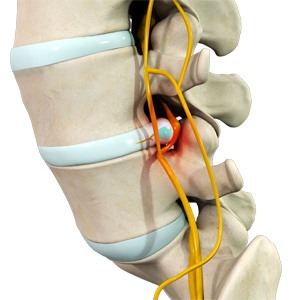
The spine is made up of a column of small bones called vertebrae that surround and protect the spinal cord and nerves that branch out from the spinal cord. Each bone or vertebra is separated from the other by a spongy tissue called an intervertebral disc, which acts as a cushion and prevents the bones from rubbing against each other during movement. Based on their position, the vertebral column is categorized into 7 cervical vertebrae in the neck, 12 thoracic vertebrae in the chest region, 5 lumbar vertebrae in the lower back, and 5 fused bones of the sacrum and 3 fused bones that form the coccyx in the pelvic region. Some of the
Common Spinal Disorders
common spinal disorders include:
Degenerative disc disease (DDD): Degenerative disc disease refers to the gradual deterioration of the intervertebral discs that cushion the vertebrae. DDD affects the strength, resiliency, and structural integrity of the intervertebral discs due to advancing age, trauma, injury, repetitive lifting of heavy objects, smoking, and obesity.
Herniated disc: Herniated disc is a condition in which the outer fibrous annulus of the intervertebral disc is damaged, causing the nucleus to protrude through the ruptured annulus and compress the adjacent nerve root and/or spinal canal. A herniated disc is also known as a slipped disc or ruptured disc.
Stenosis: Spinal stenosis is a condition caused when the vertebral column constricts and exerts pressure on the spinal cord or neural foramen (a bony tunnel through which a nerve exits the spinal cord). It usually affects the cervical and lumbar spine. If the spinal canal is narrowed, the disorder is called cervical/lumbar central stenosis. If the foramen is narrowed, it is referred to as cervical/lumbar foraminal stenosis.
Spondylolisthesis: Spondylolisthesis is a condition in which the breakdown of the cartilage between the vertebrae of the spine causes one vertebra to slip out of place on top of the one below it. This causes misalignment and narrowing of the spinal column, a condition called spinal stenosis, which can put pressure on the nerves, resulting in pain in the buttocks or legs with walking or standing.
Scoliosis: Scoliosis is a condition where the spine or backbone is curved sideways instead of appearing in a straight line. It can occur in all ages but commonly occurs in children before puberty, during their growth spurt.
Osteoporosis: Osteoporosis is a bone disease characterized by a decrease in bone mass and density resulting in brittle, fragile bones that are more susceptible to fractures. The condition most commonly affects elderly women. Osteoporosis-related fractures are more common at the vertebral bodies of the spine. Osteoporosis is called a "silent disease," as a majority of the patients may be unaware of their condition until they develop a bone fracture.
Fractures: Vertebral compression fractures occur when the normal vertebral body of the spine collapses when too much pressure is placed on the vertebrae, resulting in pain, limited mobility, loss of height, and spinal deformities. Fragile and weak bones in the elderly, and those suffering from osteoporosis and cancer can develop compression fractures with little or no force.
Tumors: Spinal tumors are an abnormal growth of tissues or cells in and around the spinal cord or vertebral bones. Tumors can either be cancerous (malignant) or non-cancerous (benign). Tumors from other parts of the body can also spread and affect the spinal column.
Infections: The spinal cord and its surrounding structures can become infected by bacteria or fungal organisms. Certain risk factors that can make you more susceptible to these infections include obesity, malnutrition, weakened immune system, infection with HIV virus, diabetes, and cancer.







